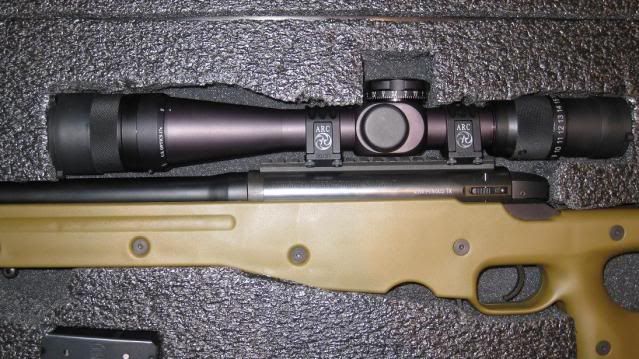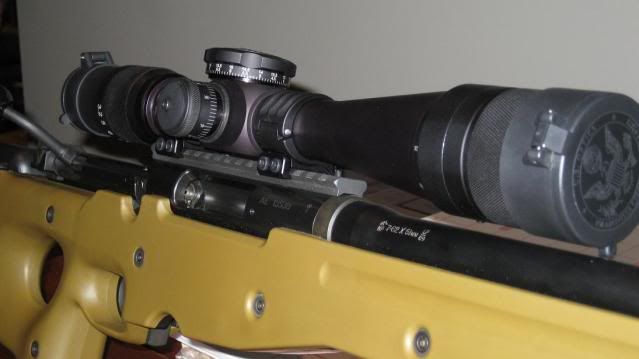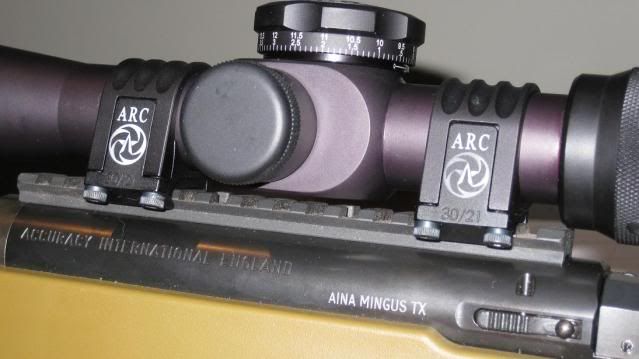<span style="text-decoration: underline"><span style="font-weight: bold">American Rifle - Generation 1 Rings, Xtra High.</span></span>

<span style="font-style: italic">Fig 1 - Assembled ring and exploded view</span>
As many shooters around here know, it's not uncommon to see a scope that has clamping marks on it. These marks are attributed to several things ranging from out of spec parts (rings or bases), to misaligned rings, or to over tightening. I have seen this firsthand on a couple of scopes that I have had in the past, one of my Nightforce NXS's still bears ring marks from the first owner. Ring lapping kits, ring alignment gauges, etc have all been proposed solutions to remedy this problem.
I did some googling to see what other ring systems might be available since the split clamp style ring is relatively unchanged for the past 50 years or more. Some companies have refined the design and they indeed provide a very high quality product, but at the end of the day the design still creates 2 "pinch points" on each side of the scope. This is driven by the fact that the deformation of the scope tube is funneled towards the tangency point at each side of the tube and a slight "bubble" is formed in the split ring. The clamping force of the ring crushes this and you get a ring mark. (see http://americanrifle.com/scope_rings/ for their full disclosure)
Rather than split the ring at the horizontal tangency point, American Rifle keeps the clamp setup so that an optimal contact is maintained and ring marks are eliminated.
OK, so that's the sales pitch anyway. I'm generally pretty incredulous when a company makes claims that involve the words "eliminate" and "never". For those that don't know, I work as a stress analyst in the Aerospace industry. Helicopters are my primary repsonsibilities now, but I've done composites, military jets and commercial transport aircraft. I'm also incredulous when snapshots from Finite Element models are shown because they're quite easy to massage until it looks good. I specialize in computational mechanics (aka FEA/FEM and analytical solutions) so I've made my fair share of them in the past few years.
I did take a closer look at the stress footprints shown and I think they're pretty close. The high pressure areas shown on the standard split ring mimic the worst cases of ring marks. Likewise, the redesign shows a significant reduction in high contact stress regions but an improvement in overall contact.
The rings are advertised to have a convex surface on the contact regions for mounting to the Picatinny Rail. This is supposed to improve the return to zero capability and the overall mounting integrity on the ring base.

<span style="font-style: italic">Fig. 2 - Convex rail contact surfaces </span>
Another feature is on the cross-bolt nut/washer. They are machined with convex/concave matching surfaces to self-center when the rings are torqued to the base.

<span style="font-style: italic">Fig 3 - Convex/Concave cross-bolt nut arrangement</span>
Initial impressions upon opening the box were great. The fit and finish is top notch and they flat out look cool. I really like that you can completely disassmble the lower portions of the rings. This makes it much easier for a colored coating to be put on by a gunsmith to match the rest of the rifle's color scheme or camouflage pattern.
The instructions are well detailed and clearly setup for everyone. There are detailed instructions for mounting with a torque wrench and detailed instructions for "finger tight, plus 1/4 turn" style assembly.
The machining is very nicely finished, there are no tooling marks, cutter marks, the AL parts fit well in the steel pieces, and the cross-bolt fits very snugly into the recess for the head. All in all, it's a high quality product that I've come to expect from somewhere that is focused on the quality and reliability, not on shoving junk out the door just to make a buck.
I put them on my DPMS LR-260 and snapped a few pictures to show the quality of the manufacturing. They zero'd out without an issue, in fact, I must have some minor offset in the previous rings I had on here because it was much closer to optically centered, the last set needed about 15 MOA left to zero.

<span style="font-style: italic">Fig 4 - Rings doing what they're supposed to do</span>
I shot the rifle off and on through the day, took the rings off the base, put them back on and fired to check the zero return. I was pleasantly rewarded with no appreciable change. The rifle shoots in the 1/2-5/8" @100yd and I saw about 1/4" of change in zero on the first round. One click down and it was back in place. I was satisfied, it's very possible that I didn't drive the rifle as well as it could have gone because I ended up returning the rifle to my marked zero before the end of the day.
The last test I did was not planned. On Friday afternoon before a saturday morning match I tripped over the dog and fell into the rifle which was leaned up to my reloading bench. The rifle slid sideways and landed smack on an ammo can and thumped the forward ring. Since the match at 830 am allowed for no zero check and the first round was 600yd on paper for score I couldn't let it go. I drove back out to the range on Friday evening and fired 5 rounds. No change.
Not only was I relieved that there was no zero change, but I have quite a bit of respect for a good set of rings now. I'm definitely pleased with these things. I didn't take any pictures during the match since it was a torrential downpour and I had no intentions of subjecting my camera to those conditions. The rings had no issues whatsoever. I did have a catastrophic failure on the charging handle which cut the match short for me, but I hit the CBS and 8/9 of the movers at 300yd. They stood up to me mortaring the rifle, using a 2x4 to smack the charging handle open (this is what bent it). I took it back out to the range this morning to see how the rings stood up to being tipped, smacked, bumped, etc and the first round hit 6" steel at 500yd. I think that's enough for me to consider them "sufficiently tough"
The downside that I see is the rings are pretty expensive at first glance. When compared to something like the Burris XTR line these are much more expensive (4x's the cost) but let's think about the relative cost of what we're dealing with. Many shooters are using EGW, Near Mfg, Nightforce, et al. ring and base sets. A set of NF rings is 140-150 bucks. They are still capable of marring up that $1600+ scope that's on there. I looked at it this way: I have $3200 in my LR-260 including the glass, would I have not bought it if I put 3200 into the rifle instead of 3150? Nope, however, if I decide to part it out and sell it, not having ring marks on the scope will easily keep the resale price 50 bucks higher, so I chalk it up as a wash in cost outlay.
In features, I think these are a huge win.
I will be ordering more rings from them as I have a 7mm BAT build coming in the near weeks, I think that American Rifle has a great product.
<span style="font-style: italic">Fig 1 - Assembled ring and exploded view</span>
As many shooters around here know, it's not uncommon to see a scope that has clamping marks on it. These marks are attributed to several things ranging from out of spec parts (rings or bases), to misaligned rings, or to over tightening. I have seen this firsthand on a couple of scopes that I have had in the past, one of my Nightforce NXS's still bears ring marks from the first owner. Ring lapping kits, ring alignment gauges, etc have all been proposed solutions to remedy this problem.
I did some googling to see what other ring systems might be available since the split clamp style ring is relatively unchanged for the past 50 years or more. Some companies have refined the design and they indeed provide a very high quality product, but at the end of the day the design still creates 2 "pinch points" on each side of the scope. This is driven by the fact that the deformation of the scope tube is funneled towards the tangency point at each side of the tube and a slight "bubble" is formed in the split ring. The clamping force of the ring crushes this and you get a ring mark. (see http://americanrifle.com/scope_rings/ for their full disclosure)
Rather than split the ring at the horizontal tangency point, American Rifle keeps the clamp setup so that an optimal contact is maintained and ring marks are eliminated.
OK, so that's the sales pitch anyway. I'm generally pretty incredulous when a company makes claims that involve the words "eliminate" and "never". For those that don't know, I work as a stress analyst in the Aerospace industry. Helicopters are my primary repsonsibilities now, but I've done composites, military jets and commercial transport aircraft. I'm also incredulous when snapshots from Finite Element models are shown because they're quite easy to massage until it looks good. I specialize in computational mechanics (aka FEA/FEM and analytical solutions) so I've made my fair share of them in the past few years.
I did take a closer look at the stress footprints shown and I think they're pretty close. The high pressure areas shown on the standard split ring mimic the worst cases of ring marks. Likewise, the redesign shows a significant reduction in high contact stress regions but an improvement in overall contact.
The rings are advertised to have a convex surface on the contact regions for mounting to the Picatinny Rail. This is supposed to improve the return to zero capability and the overall mounting integrity on the ring base.
<span style="font-style: italic">Fig. 2 - Convex rail contact surfaces </span>
Another feature is on the cross-bolt nut/washer. They are machined with convex/concave matching surfaces to self-center when the rings are torqued to the base.
<span style="font-style: italic">Fig 3 - Convex/Concave cross-bolt nut arrangement</span>
Initial impressions upon opening the box were great. The fit and finish is top notch and they flat out look cool. I really like that you can completely disassmble the lower portions of the rings. This makes it much easier for a colored coating to be put on by a gunsmith to match the rest of the rifle's color scheme or camouflage pattern.
The instructions are well detailed and clearly setup for everyone. There are detailed instructions for mounting with a torque wrench and detailed instructions for "finger tight, plus 1/4 turn" style assembly.
The machining is very nicely finished, there are no tooling marks, cutter marks, the AL parts fit well in the steel pieces, and the cross-bolt fits very snugly into the recess for the head. All in all, it's a high quality product that I've come to expect from somewhere that is focused on the quality and reliability, not on shoving junk out the door just to make a buck.
I put them on my DPMS LR-260 and snapped a few pictures to show the quality of the manufacturing. They zero'd out without an issue, in fact, I must have some minor offset in the previous rings I had on here because it was much closer to optically centered, the last set needed about 15 MOA left to zero.
<span style="font-style: italic">Fig 4 - Rings doing what they're supposed to do</span>
I shot the rifle off and on through the day, took the rings off the base, put them back on and fired to check the zero return. I was pleasantly rewarded with no appreciable change. The rifle shoots in the 1/2-5/8" @100yd and I saw about 1/4" of change in zero on the first round. One click down and it was back in place. I was satisfied, it's very possible that I didn't drive the rifle as well as it could have gone because I ended up returning the rifle to my marked zero before the end of the day.
The last test I did was not planned. On Friday afternoon before a saturday morning match I tripped over the dog and fell into the rifle which was leaned up to my reloading bench. The rifle slid sideways and landed smack on an ammo can and thumped the forward ring. Since the match at 830 am allowed for no zero check and the first round was 600yd on paper for score I couldn't let it go. I drove back out to the range on Friday evening and fired 5 rounds. No change.
Not only was I relieved that there was no zero change, but I have quite a bit of respect for a good set of rings now. I'm definitely pleased with these things. I didn't take any pictures during the match since it was a torrential downpour and I had no intentions of subjecting my camera to those conditions. The rings had no issues whatsoever. I did have a catastrophic failure on the charging handle which cut the match short for me, but I hit the CBS and 8/9 of the movers at 300yd. They stood up to me mortaring the rifle, using a 2x4 to smack the charging handle open (this is what bent it). I took it back out to the range this morning to see how the rings stood up to being tipped, smacked, bumped, etc and the first round hit 6" steel at 500yd. I think that's enough for me to consider them "sufficiently tough"
The downside that I see is the rings are pretty expensive at first glance. When compared to something like the Burris XTR line these are much more expensive (4x's the cost) but let's think about the relative cost of what we're dealing with. Many shooters are using EGW, Near Mfg, Nightforce, et al. ring and base sets. A set of NF rings is 140-150 bucks. They are still capable of marring up that $1600+ scope that's on there. I looked at it this way: I have $3200 in my LR-260 including the glass, would I have not bought it if I put 3200 into the rifle instead of 3150? Nope, however, if I decide to part it out and sell it, not having ring marks on the scope will easily keep the resale price 50 bucks higher, so I chalk it up as a wash in cost outlay.
In features, I think these are a huge win.
I will be ordering more rings from them as I have a 7mm BAT build coming in the near weeks, I think that American Rifle has a great product.

















